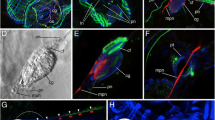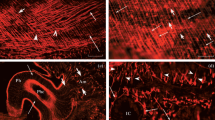Abstract
Serotonin is a widespread neurotransmitter which is present in almost all animal phyla including lower metazoans such as Cnidaria. Serotonin detected in the polyps of several cnidarian species participates in the functioning of a neural system. It was suggested that serotonin coordinates polyp behavior. For example, serotonin may be involved in muscle contraction and/or cnidocyte discharge. However, the role of serotonin in cnidarians is not revealed completely yet. The aim of this study was to investigate the neural system of Cladonema radiatum polyps. We detected the net of serotonin-positive processes within the whole hydranth body using anti-serotonin antibodies. The hypostome and tentacles had denser neural net in comparison with the gastric region. Electron microscopy revealed muscle processes throughout the hydranth body. Neural processes with specific vesicles and neurotubules in their cytoplasm were also shown at an ultrastructural level. This work demonstrates the structure of serotonin-positive neural system and smooth muscle layer in C. radiatum hydranths.





Similar content being viewed by others
References
Anctil M (1989) Modulation of a rhythmic activity by serotonin via cyclic AMP in the coelenterate Renilla köllikeri. J Comp Physiol B 159:491–500
Anderson P, Thompson L, Moneypenny C (2004) Evidence for a common pattern of peptidergic innervation of cnidocytes. Biol Bull 207:141–146
Carlberg M, Anctil M (1993) Biogenic amines in coelenterates. Comp Biochem Physiol 106C(1):1–9
De-Miguel FF, Trueta C (2005) Synaptic and extrasynaptic secretion of serotonin. Cell Mol Neurobiol 25(2):297–312
Elofsson R, Carlberg M (1989) Gland cells in the tentacles of the jellyfish Cyanea lamarcki reactive with an antibody against 5-hydroxytryptamine. Cell Tissue Res 255:419–422
Falugi C, Morri C, Bouillon J, Boero F (1994) Localization of some neurotransmitters during development in hydroidomedusae. Tissue Cell 26:523–538
Gerry SP, Daigle AJ, Feilich KL, Liao J, Oston AL, Ellerby DJ (2012) Serotonin as an integrator of leech behavior and muscle mechanical performance. Zoology 115:255–260
Golz R (1994) Occurrence and distribution of RFamide-Positive Neurons within the Polyps of Coryne sp. (Hydrozoa, Corynidae). Biol Bull 186:115–123
Grimmelikhuijzen CJ (1983) FMRF-amide immunoreactivity is generally occurring in the nervous systems of coelenterates. Histochemistry 78:361–381
Honegger TG (1984) Ultrastructure of the adhesive tentacles of the limnomedusa Vallentinia gabriella (Hydrozoa, Olindiadidae). Zoomorphology 104:26–32
Kass-Simon G (1972) Longitudinal conduction of contraction burst pulses from hypostomal excitation loci in Hydra attenuata. J Comp Physiol 80:29–49
Kass-Simon G, Pierobon P (2007) Cnidarian chemical neurotransmission, an updated overview. Comp Biochem Physiol Part A Mol Integr Physiol 146(1):9–25
Lloyd PE, Kupfermann I, Weiss KR (1984) Evidence for parallel actions of a molluscan neuropeptide and serotonin in mediating arousal in Aplysia. Proc Natl Acad Sci USA 81:2934–2937
Mackie GO, Meech RW (2008) Nerves in the endodermal canals of hydromedusae and their role in swimming inhibition. Invert Neurosci 8:199–209
Mackie GO, Marx R, Meech RW (2003) Central circuitry in the jellyfish Aglantha digitale. IV. Pathways coordinating feeding behavior. J Exp Biol 206:2487–2505
Mayorova TD, Kosevich IA (2013) FMRF-amide immunoreactivity pattern in the planula and colony of the hydroid Gonothyraea loveni. Zoology 116(1):9–19
Miglietta MP, Tommasa LD, Denitto F, Gravili C, Pagliara P, Bouillon J, Boero F (2000) Approaches to the ethology of hydroids and medusae (Cnidaria, Hydrozoa). Scientia Marina 64:63–71
Oliver D, Brinkmann M, Sieger T, Thurm U (2008) Hydrozoan nematocytes send and receive synaptic signals induced by mechano-chemical stimuli. J Exp Biol 211:2876–2888
Sakaguchi M, Mizusina A, Kobayakawa Y (1996) Structure, development, and maintenance of the nerve net of the body column in hydra. J Comp Neurol 373:41–54
Satterlie R (2008) Control of swimming in the hydrozoan jellyfish Aequorea victoria, subumbrellar organization and local inhibition. J Exp Biol 211:3467–3477
Schuchert P (2006) The European athecate hydroids and their medusae (Hydrozoa, Cnidaria): Capitata Part 1. Rev Suisse Zool 113(2):325–410
Sloley BD, Juorio AV, Durden DA (1990) High-performance liquid chromatographic analysis of monoamines and some of their γ-glutamyl conjugates produced by the brain and other tissues of Helix aspersa (Gastropoda). Cell Mol Neurobiol 10(2):175–192
Seipel K, Schmid V (2006) Mesodermal anatomies in cnidarian polyps and medusae. Int J Dev Biol 50:589–599
Stokes D (1974) Morphological substrates of conduction in the colonial hydroid I. An ectodermal nerve net. J Exp Zool 190:19–46
Takeda N, Svendsen CN (1991) Monoamine concentrations in Hydra magnipapillata. Hydrobiologia 216(217):549–554
Tardent P, Schmid V (1972) Ultrastructure of mechanoreceptors of the polyp Coryne pintneri (Hydrozoa, Athecata). Exp Cell Res 72:265–275
Thomas MB, Edwards NC (1991) Cnidaria: hydrozoa. In: Harrison FW, Westfall JA (eds) Placozoa, Porifera, Cnidaria, and Ctenophora. Wiley-Liss, Inc, New York, pp 91–183
Turlejski K (1996) Evolutionary ancient roles of serotonin: long-lasting regulation of activity and development. Acta Neurobiol Exp 56(2):619–636
Umbriaco D, Anctil M, Descarries L (1990) Serotonin-immunoreactive neurons in the cnidarian Renilla koellikeri. J Comp Neurol 291(2):167–178
von Bohlen und Halbach O, Dermietzel R (2006) Neurotransmitters and Neuromodulators. WILEY-VCH Verlag GmbH & Co. KGaA, Weinheim
Walker RJ, Papaioannou S, Holden-Dye L (2009) A review of FMRFamide- and RFamide-like peptides in metazoa. Invert Neurosci 9:111–153
Weber C (1989) Smooth muscle fibers of Podocoryne carnea (Hydrozoa) demonstrated by a specific monoclonal antibody and their association with neurons showing FMRFamide-like immunoreactivity. Cell Tissue Res 255:275–282
Welsh JH, Loveland RE (1968) 5-Hydroxytryptamine in the Ascidian, Ciona intestinalis L. Comp Biochem Physiol 27:719–722
Westfall JA (1973) Ultrastructural evidence for neuromuscular systems in coelenterates. Am Zool 13(2):237–246
Westfall JA (1996) Ultrastructure of synapses in the first-evolved nervous systems. J Neurocytol 25:735–746
Westfall JA, Grimmelikhuijzen C (1993) Antho-RFamide immunoreactivity in neuronal synaptic and nonsynaptic vesicles of sea anemones. Biol Bull 185:109–114
Westfall JA, Elliott SR, MohanKumar PS, Carlin RW (2000) Immunocytochemical evidence for biogenic amines and immunogold labeling of serotonergic synapses in tentacles of Aiptasia pallida (Cnidaria, Anthozoa). Invertebr Biol 119(4):370–378
Acknowledgments
We are grateful to the staff of the Laboratory of Electron Microscopy (Faculty of Biology, Moscow State University), Prof. N. Dulin (Chicago University) and Optical Research Group (Institute of Developmental Biology RAS, Moscow) for technical assistance.
Conflict of interest
None.
Author information
Authors and Affiliations
Corresponding author
Rights and permissions
About this article
Cite this article
Mayorova, T.D., Kosevich, I.A. Serotonin-immunoreactive neural system and contractile system in the hydroid Cladonema (Cnidaria, Hydrozoa). Invert Neurosci 13, 99–106 (2013). https://doi.org/10.1007/s10158-013-0152-2
Received:
Accepted:
Published:
Issue Date:
DOI: https://doi.org/10.1007/s10158-013-0152-2




